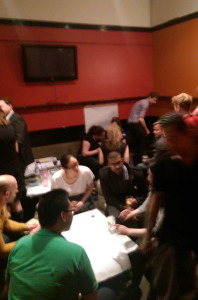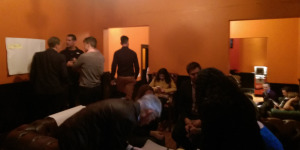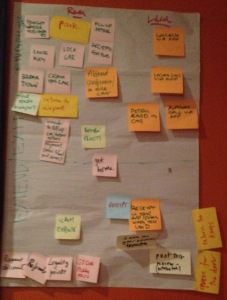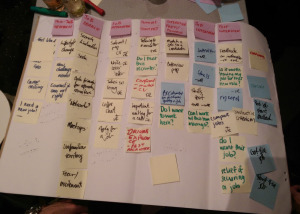Last Thursday evening, we had a full house for Rob McLellan & Will Fettke from Telstra Design Practice to talk about understanding your customer through design thinking and customer journey maps.
Customer Journey Maps document your customer’s end-to-end experience in order to understand how they interact with you. Maps will help identify areas that need improvement but they can do much more – use them to help shape your roadmap, prioritise the backlog or even find pain points that need to be mitigated before launch.
Of course, this is also another tool to help you understand your customer! Try using the map as a communication tool to help your entire team (or company) have more empathy towards the user.
The map visually represents the experience with information like customer goals, touch points, the customer’s emotions and more. Internally, since the maps are highly visual and often on a wall, they get more interest than a text document sitting in email.
During their time at Telstra, Rob & Will have seen a company wide shift towards understanding the value of design thinking including helping to guide strategy. When the internal teams have been involved in mapping, there’s no need to sell the learnings to them… they have personal experience in creating the learning. Rob & Will have witnessed how the maps enable people to have empathy for the customer, even when that requires them to swallow their pride. Out of all the design thinking tools, they use customer journey maps the most at Telstra.
Rob pointed out the value of these tools come at the upfront stage – to guide you to the problem space and getting everyone to think about it in the same way. Customer journey maps are not going to help you with the interface. Rob said the other big value is using this tool to help identify the opportunities to take it to the next level.
Maps are great for showing nothing happens in isolation. One thing the guys have witnessed is anything you do with customers is ‘a conversation’. An advert, text on a bill, etc come back as ‘Telstra told me’. A great insight for so many parts of the business!
When starting a project, Rob & Will have their stakeholders map the experience first to get the internal view of what’s happening then they they map the experience with customers. Looking at the gaps between those 2 maps are some of the most valuable pieces of information.
As usual at a Product Anonymous session, it was time for the audience to get involved. Rob & Will outlined our task – to redesign an experience such as shopping or public transit.
First we had to take over other sections of the bar so we had enough space 🙂 Then each group had to define what experience to work on. Our groups went with:
- going to Oaks Day
- renting a car
- dealing with a lost myki
- buying tickets for the Grand Final
- finding a job/recruitment
- renting a car for a business trip
They mapped out the experience then broke the experience into themes. Next, they looked at touch points along the timeline which lead into emotions and pain points. To finish up, each group focused on 2-3 really painful things and how they could solve them.
Some examples:
Themes for attending Oaks Day include organisation, preparation, arrival, interacting and leaving.
Touch points of finding a new job included: coffee chats with recruiters, searching online, going to meetups, lots of time at your computer crafting cover letters & resumes.
Emotions & pain points for dealing with a lost myki card include: annoyance, relief & satisfaction, frustration, confusion, more annoyance, more confusion and finally more frustration!
Each group presented their experience map & solution.
Rob & Will gave a summary before we broke out into groups & coached each group though the process. For those who weren’t able to attend – here’s an overview!
Using your post-its, write out all the things that happen during the experience from the customer’s perspective. Moving the post-its around, you can put them in time sequence within a swim lane. Include items like who they interact with, how long the interaction lasted, direct quotes, etc.
Use the 5 E’s to help explain the experience:
- Entice – how does the customer become aware
- Enter – how does the customer begin the engagement with your service
- Engage – what are the points of interaction they can have with you and your offering
- Exit – how does the experience close out
- Extend – how could you extend the experience
Think about how you can cluster the steps into ‘episodes’.
Touchpoints – group the journey into the specific touchpoints they interact with you or your service, i.e over the phone, on a device, in a shop, whatever that might be. Draw out some of the emotions that might be felt by the customer at this stage. These steps can then be turned into customer needs, which leads to the discovery of pain points and real opportunity for change or improvement.
Look for the biggest pain points and brainstorm on how to solve those. At this stage be very open to any idea and only after you have put a lot of ideas forward narrow the options down again. Don’t kill ideas in the brainstorm phase as there are plenty of chances for narrowing the list down to only the most plausible.
The next step is to test out those ideas and see what will really work. Testing them can be as simple as a sketch. Will said they often put sketches in front of customers to test solutions.
Tips for Mapping
- Starting is the hardest part.
- Mapping takes time. Ensure you have committed time with stakeholders and time to both learn AND fail.
- Your maps will evolve over time.
- This isn’t rocket science! But it is a powerful tool to share with others in order to gain agreement & understanding.
Interested in learning more?
- The Anatomy of an Experience Map / Adaptive Path
- Designing CX
Thanks!!!
Thank you Rob & Will for taking the time to share your knowledge! Thanks to everyone who came along! We hope to hear about mapping escapades soon! See you all at Product Camp on the 4th!!






